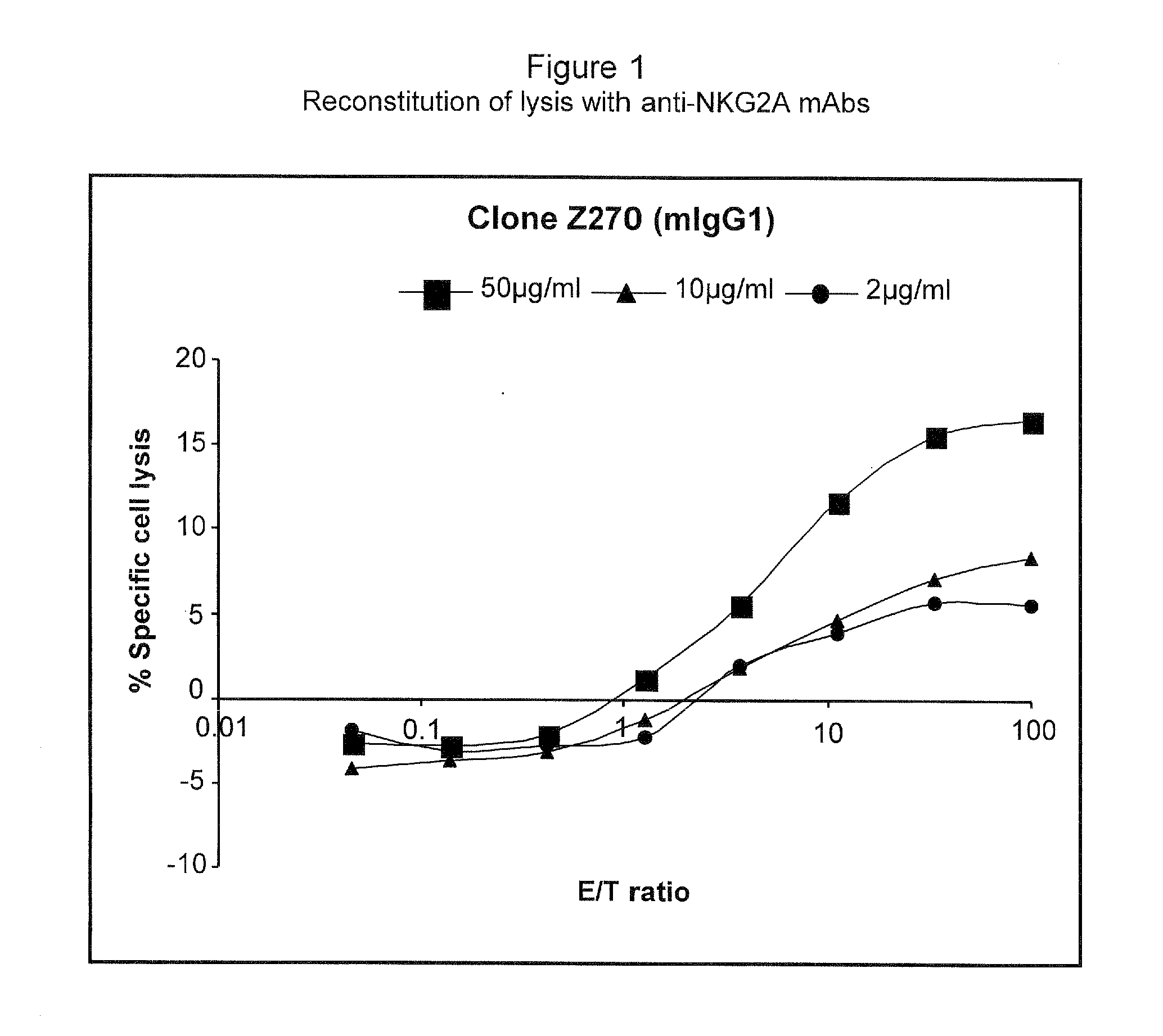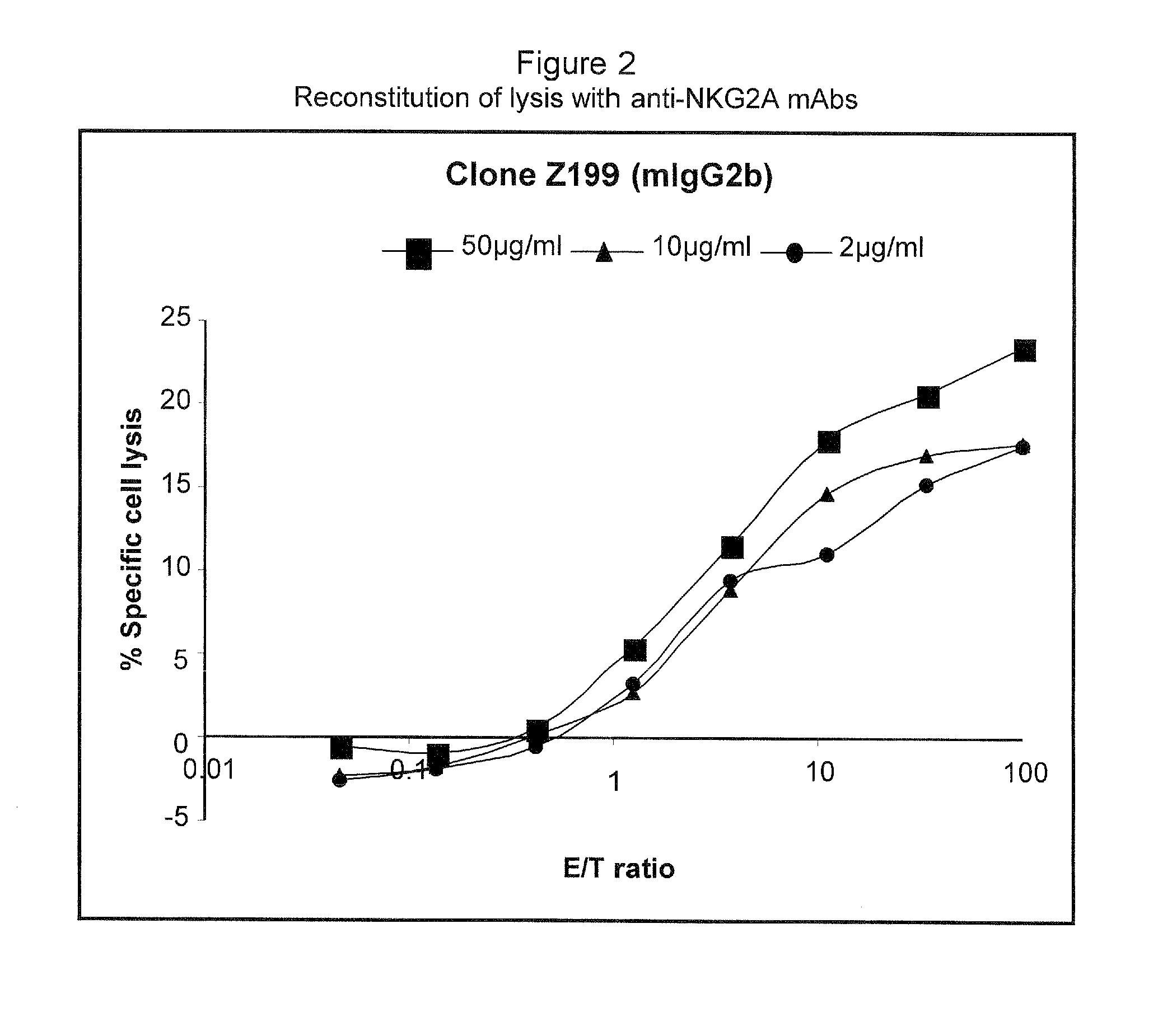Monoclonal Antibodies Against NKG2A
a monoclonal antibody and nkg2a technology, applied in the field of monoclonal antibodies, can solve the problems of preventing studies in nonhuman primates, and achieve the effect of reducing the number of nk cells in a cell population and reducing the nk cell-mediated lysis of cells
- Summary
- Abstract
- Description
- Claims
- Application Information
AI Technical Summary
Benefits of technology
Problems solved by technology
Method used
Image
Examples
example 1
Killing of Autologous iDC is Mediated by a Subset of CD94 / NKG2A+KIR-NK Cells
[0239]Polyclonal NK cells cultured in the presence of exogenous IL-2 were previously shown to display strong cytolytic activity against iDC. Accordingly, in the present study, polyclonal NK cell populations isolated from donors AM, AC and DB efficiently killed both autologous and allogeneic iDC. However, the cytolytic activity against autologous iDC could be incremented in the presence of appropriate anti-HLA class I mAb.
[0240]These data could be the consequence of the disruption of inhibitory interactions occurring between self HLA class I on DC and inhibitory receptors on NK cells. On the basis of these results, we formulated the hypothesis that only a fraction of the total NK cell pool displays spontaneous cytotoxicity against iDC whereas the other NK cells do not because of effective inhibitory interactions between their receptors and HLA class I molecules. To analyze this possibility, a panel of NK cell...
example 2
The Susceptibility of iDC to NK-Mediated Cytotoxicity Reflects the Down-Modulation of HLA-E Class I Molecules
[0247]Previous studies demonstrated that iDC and mDC display remarkable differences in terms of HLA class I surface expression. Thus, by the use of mAb specific for a monomorphic determinant of HLA-A, B, C and E molecules, it has been shown that DC undergoing maturation greatly up-regulate their HLA class I expression at the cell surface. Moreover, the up-regulation of HLA class I represented a crucial mechanism by which mDC become resistant to NK-cell-mediated lysis.
[0248]To directly assess the expression of various HLA class I molecules on cells representative of different stages of DC maturation we comparatively analyzed the expression of HLA-A, B, C and E on monocytes, iDC and mDC derived from the same individual. All HLA class I molecules were highly up-regulated in mDC as compared with iDC. Remarkably, they were clearly down-regulated in iDC as compared with monocytes (...
example 3
A Small Fraction of NK Clones can Mediate Killing of mDC
[0250]Consistent with previous reports that polyclonal NK cells do not efficiently kill mDC, we show that most NK cell clones that lysed iDC did not to kill mDC. Interestingly, however, mDC were lysed by a minor fraction of NK clones belonging to group A (i.e. those displaying spontaneous anti-iDC cytolytic activity that could not be increased by anti-HLA class I mAb). Lysis of autologous mDC was lower as compared with that of iDC and could be increased in the presence of anti-HLA class I mAb. This suggests that the higher expression of HLAE in mDC as compared with iDC results in a more effective signaling via CD94 / NKG2A (this is also suggested by the ability of anti-CD94 mAb to increase their lysis). Concerning group B NK clones (i.e. capable of killing iDC and whose lysis was incremented by anti-HLA class I mAb), they displayed no cytolytic activity again mDC; however, cytolytic activity could be revealed in the presence of a...
PUM
| Property | Measurement | Unit |
|---|---|---|
| pH | aaaaa | aaaaa |
| decay energy | aaaaa | aaaaa |
| decay energy | aaaaa | aaaaa |
Abstract
Description
Claims
Application Information
 Login to View More
Login to View More - R&D
- Intellectual Property
- Life Sciences
- Materials
- Tech Scout
- Unparalleled Data Quality
- Higher Quality Content
- 60% Fewer Hallucinations
Browse by: Latest US Patents, China's latest patents, Technical Efficacy Thesaurus, Application Domain, Technology Topic, Popular Technical Reports.
© 2025 PatSnap. All rights reserved.Legal|Privacy policy|Modern Slavery Act Transparency Statement|Sitemap|About US| Contact US: help@patsnap.com



